One of the most common driving forces behind opening a coliving is the wish to share your passions with others. In a way, most colivings are born from the philosophy of “if you can’t find the perfect thing, build it yourself”.
In the same manner, Ola and Fede started The Eatinerant, a digital nomad retreat for lovers of cuisine and wine. After a number of retreats, this simple concept that gathered like-minded people around a shared passion quickly opened the doors to new possibilities, and one of those doors led The Eatinerant right to coliving.
Although nothing in life is perfect, some things are just right, and opening the doors of the first Eatinerant coliving in Capranica was exactly that.
Now, Ola and Fede are up for a new challenge, an endeavor both very similar and very distant from their previous experience in the retreat industry. Read our interview with them to find out more about their journey, why and how it led them to coliving, and how they are planning to use their previous experience to create a completely new one.
Below is the first part of the interview where we speak about their beginnings with retreats and the plans they have with the coliving. The second part of the interview is coming out on 12.01.2023. where you will have the opportunity to read their opinions on coliving in general, the future of the coliving industry, management practices, and so on.
Enjoy!
How it all started
1. We can start with the first question. If you can tell me a little bit more about how The Eatinerant was born and how you started working together, and a little bit about the journey behind like this phase of professional life.
Ola: The Eatinerant was born at the beginning of 2022. The idea behind it was born when Federico and I met at a retreat where we met a lot of our current friends as well, and we were quite inspired by how one week can impact you and what kind of bonds you can create in just one week.
So, from that moment, we always had that thought in the back of our minds. And then, one day, we were going to work close to a lake in Italy, and we saw many properties. It was close to Rome, in Lazio, where the coliving is today, and we saw many big, beautiful properties that were not really used or abandoned.

So, after that, we started thinking how amazing it would be just to use these properties, be in nature, and invite other remote workers and digital nomads to come to work there. And then we thought – okay – let’s do it. And that’s how it was born.
2. How did you decide to start hosting The Eatinerant retreats?
Fede: When we went to work by this lake, we were thinking about how beautiful these properties were, and how beautiful Italy was, especially in summer. Both of us were really into food, so instead of creating a retreat that could be found anywhere, just gathering people and co-working, we decided to focus on food. So, what we made, and the idea behind the retreat was to gather digital nomads and remote workers, and create a community, but offer them a culinary experience.
So, what we wanted to do with The Eatinerant was focus on the countries with the biggest food culture. We started in Italy because it was the easiest way. We found properties around, and I have a background in the kitchen, I used to work in Italian gourmet restaurants, so I have some skills in cooking, especially Italian food, and that’s how it started. We both really love Italian food, so we started with that, but now we’re going to do Vietnamese as well.
When we came up with the idea, we were not even thinking about segmenting the audience or aiming to do something differently from other work retreats or food retreats. We didn’t really do the market research. We just felt that it was the right thing to do because we were really into traveling and connecting with people, working together, and into food a lot. So, there wasn’t a better idea.
Ola: Yes! I think the hidden meaning behind it was to meet people that are the same as us when it comes to discovering the world, but who also really enjoy good food or cooking together.
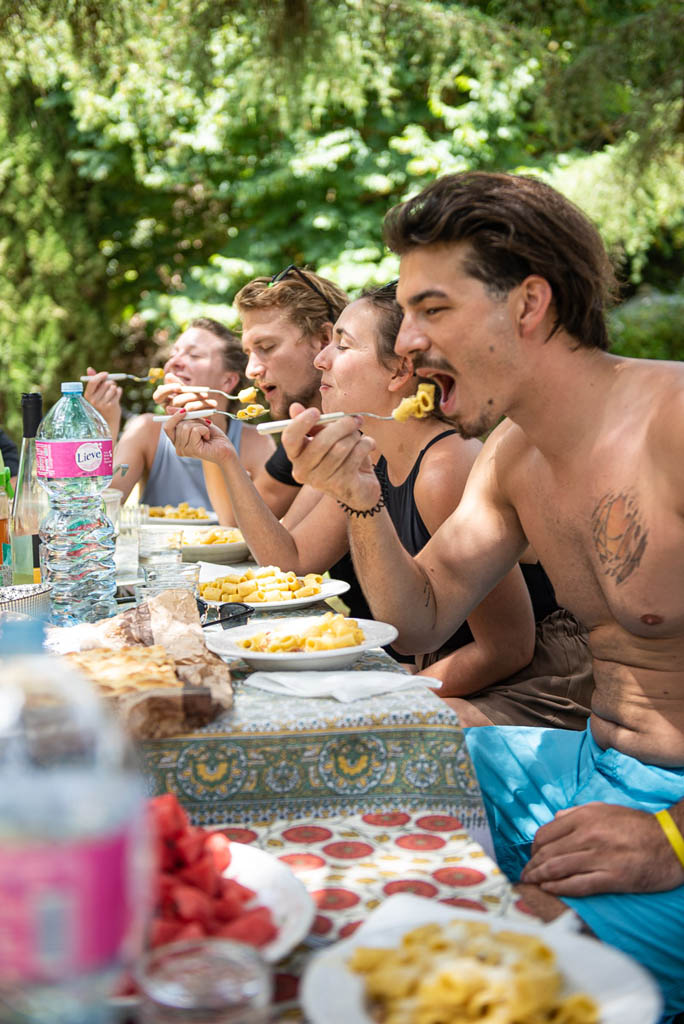
We thought– okay – we’re going to create a framework that is perfect for people like-minded to us and that would attract new people to us. And in the end, it was true, because we met many people that we’re still very close with.
3. Why and how did you decide to build the coliving on top of the retreats?
Ola: I think two factors weighed in. One factor was that, at the end of the retreats, we were feeling so connected with participants, and it was a bit sad to say goodbye. That was just one week. So, that’s why we first started thinking about longer experiences, but since retreats are created experiences where we take care of all the activities, all things, and all the food, it was not something we could really do for a longer period because the amount of work we have to put behind the scenes on it is demanding.
Then, on the other side, we were very lucky with the property, and we really saw how it can be shared among people because it has a big table, a fireplace, a big garden, and so on. We were thinking how this property would be something where we would love to live with our friends or just invite people we’d like to stay there. So, these two factors combined and brought us to the co-living idea.
And work in a coliving is not as filled with events on daily basis. You have more weekly events, and people are maintaining their routines. But because you’re staying longer, you can still have enough time to connect with everyone, and that’s why in a coliving you don’t expect that people will come for two, or three days, and you have a lot of time to discover each other.
Fede: I think another major factor is the landlord. In our case, not only the property was amazing, but the landlord was great too.
For the coliving, we just asked for everything we needed. We bought bikes so people can go around, to hikes, to the lake, and around the villa, and we upgraded the because, being secluded, it was a bit rough. I just had to ask him. I said, let’s put Starlink, and indeed he did. So now we have Starlink in our coliving, and I think it’s the first one. It’s probably the first one in Italy. And the third one is also the mattresses and all those little details that are important. He just updated everything. We bought new desks and new mattresses for the participants who will come.
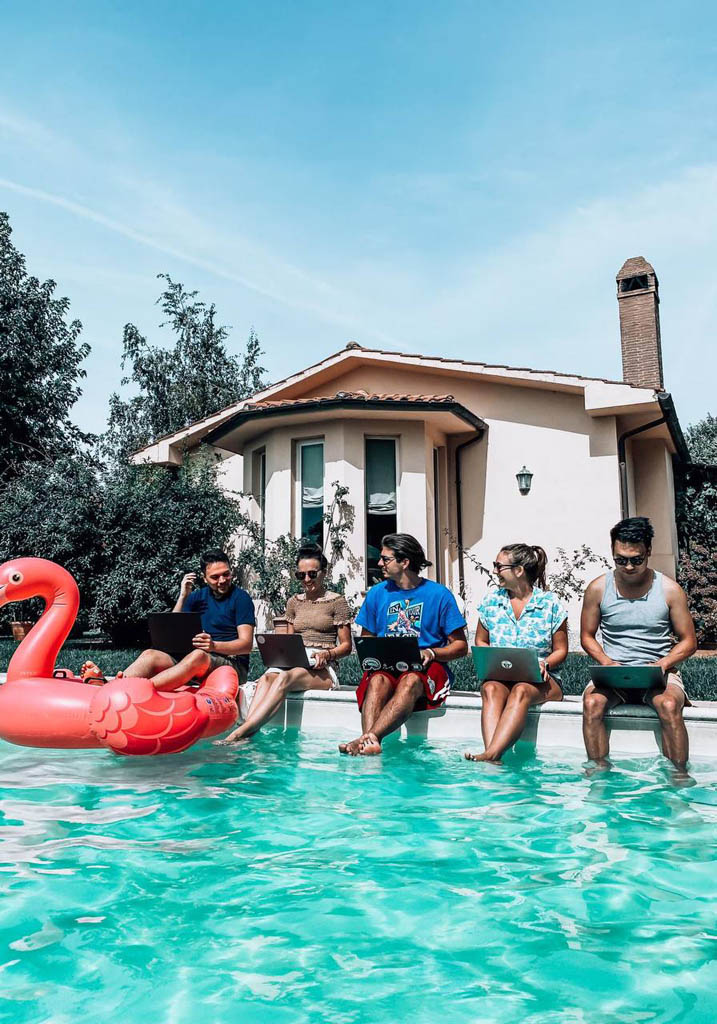
So, the place has to be great, but also the owner, because when you rent to rent, it’s usually something really hard to do, especially if you’re in countries like Italy or Portugal where they’re a bit close-minded, and they want to keep stuff for their own. So that’s a major factor too. So, three.
4. Have you had the opportunity to stay in some other coliving spaces or any similar type of accommodation before you decided to open your own place?
Fede: Personally, I think it depends on how you define coliving. After I left home, after high school, I moved abroad and, of course, I was living in apartments with tenants and friends. And that’s already a co-living. So, technically yes, I experienced this, but coliving with other remote workers and nomads, I never did.
Ola: From my side, I started a little bit with Selina, which is not exactly a co-living, but I mean now they have a co-living, I believe. But I stayed in Lisbon and Porto, where they also provided events for the community. Even so, it’s still not really a coliving because you still feel a little bit detached from the rest, not exactly the created co-living.
But, in Madeira, we stayed together with other digital nomads, so it was kind of the same experience because we hosted a lot of dinners and connection evenings.
I really liked how the space was organized in Selina in Porto. They have a garden and rooms around them. It gives you a nice, cozy feeling because everyone hangs out in the garden. So that’s what I really liked. In Lisbon, I couldn’t find this common space where everyone gathered.
5. Did you find inspiration in some other coliving spaces in Europe (or beyond) that influenced your approach to building your own space?
Ola: I think there are some colivings I’m following on Instagram, and I like the story that they’re telling behind them.
One is Evolve Co-Living in Malta. That’s the one that I really like how they explain and educate the audience on what co-living is. For example, my friend, who’s not from the digital nomad world, found it only because they were explaining so well what it is, so she went there.
The other one we also looked into was Sende, in Spain because of the rural co-living. We were from the beginning a bit concerned that the villa is too secluded, so we started looking for other secluded places and that’s how we found Sende. They are a great example of how you can bring people to a rural place.
And the third one was Dwell coliving. I really like how they renovated and how the workspace is structured. I think it’s very important how the place is set inside, so that’s what I look for as well in the colivings. If you have a nice view and you can work with a sea view, it’s amazing. I think that’s one of the selling points, at least for me.
6. You hosted 3 different coliving retreats so far. In what ways are you hoping this experience to transfer to opening a coliving? What are some of the key differences/challenges?
Ola: I think one of the like main learnings is to remain flexible because there are many unexpected things, even when you think you thought everything through. For us, who are creating the experience, no matter how well we are prepared, there will always be some unexpected things coming up, and it’s important how we react to them because it also reflects on other participants.
So as long as we are taking everything lightly and without stress, I think other people will, too. If you’re getting stressed as a host of the event, you can easily spread the negative energy.
I would say as a host of the retreat and in the future a community manager of the coliving, it’s important to see how people integrate because in the end, looking at the group dynamics, it’s important that everyone feels integrated and no one is left behind.
Also, one of the greatest learnings that we assumed and later confirmed with the retreats is that food connects people. Sharing a meal together is an amazing experience. We did food retreats with fish, Italian food, and so on, but we also had a few evenings where participants would cook.
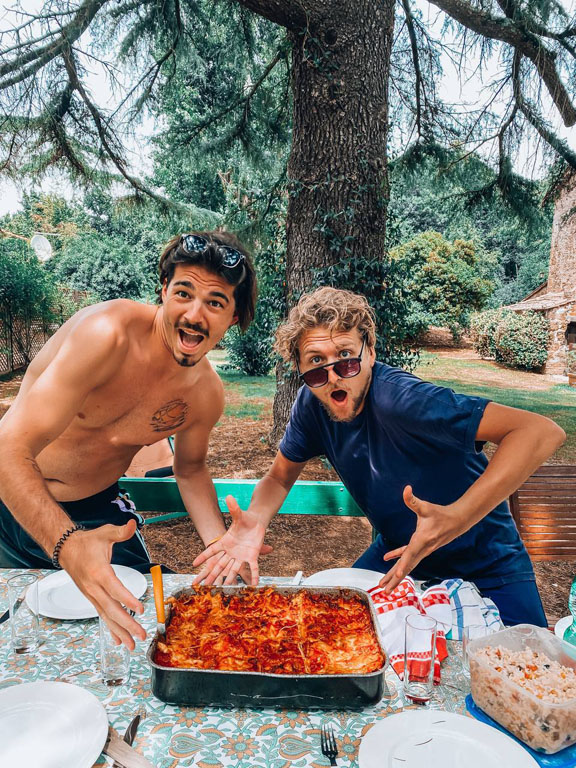
They would sometimes prepare their national dishes, and that was also a great sharing experience: discovering each other’s cultures through food. That’s something we want to keep for our coliving as well. That tradition of cooking together, having dinners together, maybe also lunch. It depends of course on the schedule, but we would at least like to organize dinners from time to time where everyone can sit around one table.
If everything goes by plan and we start in January, we’re going to have the first group come at the same time, but then people will come in the middle of the month so to help them integrate, especially in winter, we’re going to gather around the fireplace and, because it’s Italy, we will also have great wine. So, all of these little details we think will matter and we expect that the group will really feel connected.
7. What is your relationship with other coliving spaces in Italy/Europe? Do you receive support or advice from some of them?
Ola: Because we are coming from the retreat space, we received support from other retreat creators in the beginning. Some of the retreat creators also did colivings but more of popup colivings for one to two months in a certain villa.
We also know some people from Co-liv, so they also gave us advice because they work with coliving spaces, so that was very valuable.
Fede: There was also a lady that recently had a popup in Tuscany in a little village. We got to know each other through Facebook groups so we also received some advice from her.
Ola: I think overall, now that we get a bit more visibility on social media, more retreat or coliving creators reach out to us to exchange tips, but also the mistakes of the past. Overall, it’s a very supportive community.
We don’t see it as competing as it could be in many other industries where you keep your findings to yourself, but rather as creating a safe space where nomads and remote workers can migrate from one coliving to another and feel great in each space.
In the end, we’re doing it for the community. And we don’t want to look only at The Eatinerant community. We want to look beyond and on the community of remote workers in general.
Fede: I think all of us feel like a big family of remote workers, so we’re willing to help each other instead of competing.
It’s almost like we are brothers and sisters. Always trying to get people to go remote and promote this lifestyle.
8. What is the story behind you choosing Capranica as the location of The Eatinerant coliving?
Fede: The story behind it is that after we met, we did a couple of trips together, and then decided to come to Italy and were looking for places in the area of my hometown, just an hour from Rome. We wanted to find a place close to the lake where we first got this idea, but then we decided to broaden the area a bit and found this place in Capranica.
This is not a known town. It is just a typical Italian borgo with a super old medieval center with a residential area built around the old town. And only a kilometer outside the town, there’s this villa, and that’s how we chose it.
Ola: We were more into the villa than into the city of Capranica because the villa has a private path to the forest. It is perfect for someone who loves nature and wants to come and focus on their work, but also doesn’t want to be alone, because especially in smaller towns, it’s very easy to feel lonely, especially being a foreigner.
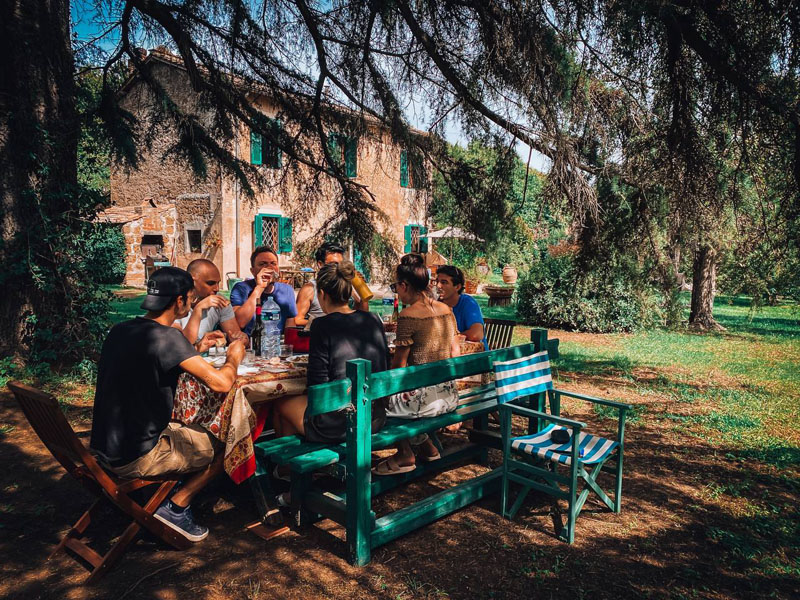
Fede: Capranica has around 5000 people, but we were not expecting the place to be so amazing. We found it on Airbnb and the pictures were not describing it as it really is. So, when we went there, we realized it has a 300-meter entrance, a path that brings you to the property, which makes the villa very secluded, but the town is actually right there in two minutes.
Ola: Even though the road is right there, because of this little entrance that you have to drive through, you feel like you are completely in nature and yet the town is right there. So, all the groceries or whatever you might need are right there.
Fede: When we were looking for properties and getting inspiration from other places, we’ve seen some secluded places to which you had to drive a lot to get. So, with our villa, the vibe is the same as these places, but fortunately, the reality is that it is not secluded. We’re also super close to Rome so that’s also very well connected.
Management
9. What type of management will you practice in the coliving, and how much will you be involved – the two of you?
Ola: At the start, our community manager is going to be the most involved because we will still be in Asia hosting the retreat in Vietnam. We have a very experienced community manager who has been in the coliving and hospitality industry, working with hotels, for 20 years.
So, it’s someone who is really into community building, who is also a digital nomad, so someone who understands the struggles of the community and will tackle all the points. But of course, we work in cooperation, the three of us, and the landlord.
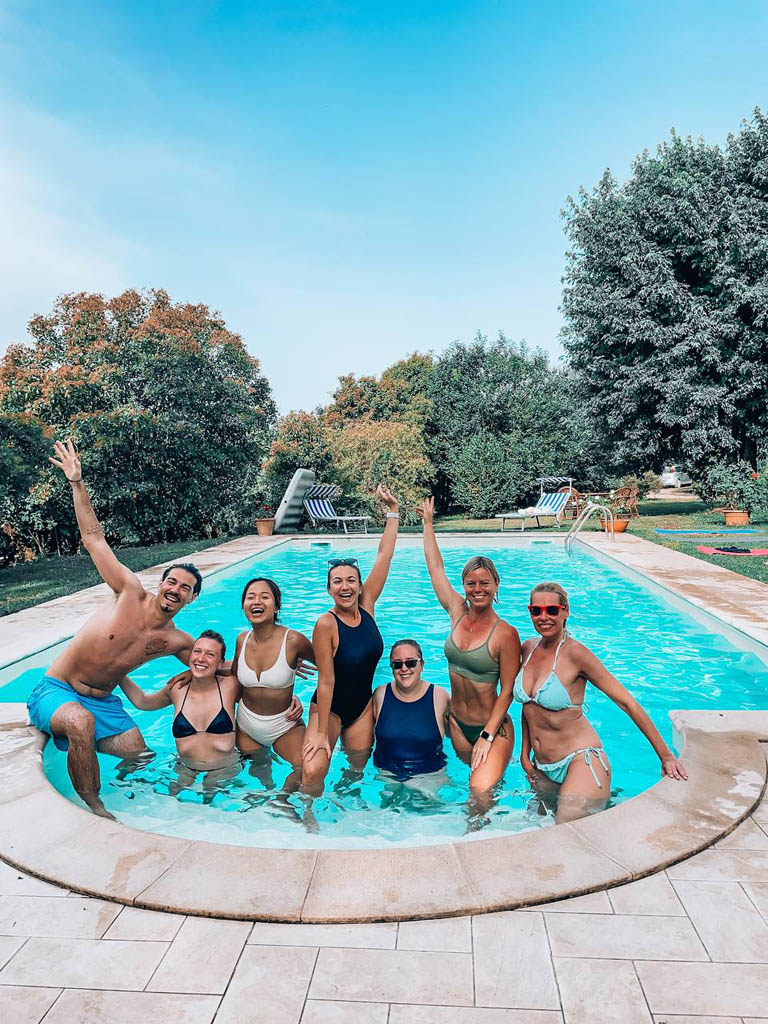
And then, once we are back, we also plan to spend some time in the coliving ourselves and facilitate more events, such as professional and personal growth events. We want the participants to also have the output of living together and that’s why we want to host more events on the spot with them.
10. You’ve hosted retreats in the past (and you still do), and now, you’re opening a coliving. Will there be a connection between people who come to your retreats and people who will stay in the coliving?
Fede: For us as the hosts of Food Retreat, for sure, the two things will eventually cross. There will be people in the coliving interested in the food retreats and vice versa. With both, we’re targeting the same group of people, digital nomads, so the community will be more or less the same, only the experience will be different.
Ola: We definitely want to cross-promote both projects. It’s also easier for us because both for coliving and for a retreat you have to have a discovery call first. Something like a pre-approval to avoid hostel vibes or Airbnb vibes. That’s why you cannot just book a retreat or coliving directly on the website, instead, you have to go through a discovery call. So, for us, once the person is approved and we see that it’s a fit for the community we are building, then it’s also easier to join the retreat after the coliving and vice versa. And to encourage this, we are also going to offer discounts for participants.
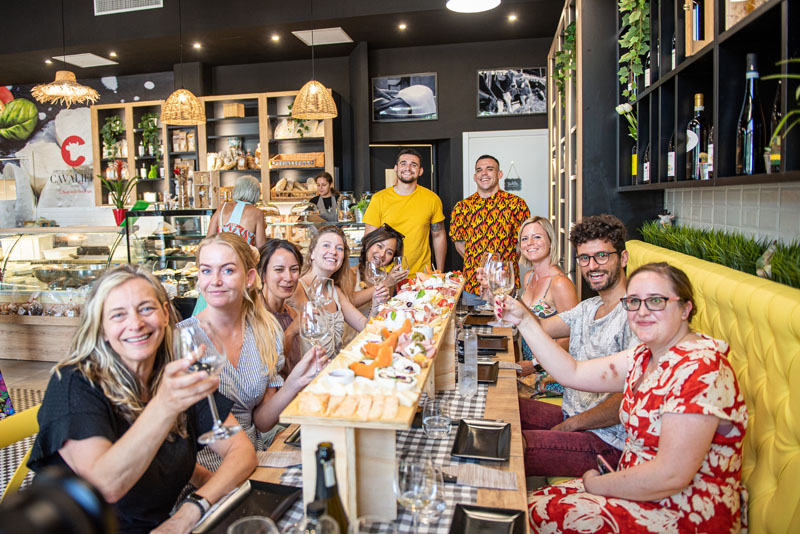
We already have some participants from January that would be interested in joining our retreats in Italy later this year, in April and May.
What we see also is that some of our participants look into moving to Italy for some time and they take the coliving as the first step so they wouldn’t have to go alone and start discovering the country alone, but rather start with the coliving and get a bit familiar with locals and the local culture, and then make the move to rent a longer-term place in Italy.
So, we definitely see that there is a connection.
11. What kind of activities will be included for people who decide to stay at your place? And now for the coliving, how that will be different when it comes to activities compared to your retreats?
Ola: Regarding the retreats, the weekends are all discovering around, because we have only one weekend. And then during the week we mostly stay at the villa. In the summer we always stayed outside. And the last retreat we did in October, we spent all evenings by the fireplace because it was really good.
Fede: Yes, the activities on the weekend that we do outside are really cool because we go to Tuscany to do wine tasting and learn about how to make wine and the story behind it, then we go to a place called Casca Del Mulino, which are natural hot springs, beautiful and super Instagramable. We typically spend the whole day in Tuscany drinking wine and visiting the cheese factory.
We learned how to make mozzarella with local cheese. The family that owned the company are old friends of my family, and they have this nice farm where they make the cheese, and we bring people there.
The activities that we do inside as mastermind skill shares or connection games, all these things are going be led by the community manager.
We are still going to do the same activities or karaoke TV nights, all these things that you can do inside or outside. The activities that we listed before are still going to be offered to do but will be optional. So, people can book the experience and they can go to Pitano, for example, which is a small town in Tuscany, super well known for wine.
So, activities are still going to be the same, but the coliving will be part of the experience as well..

Ola: In the coliving, we will still offer daily yoga classes free of charge because our community manager is also a yoga instructor.
I think it’s important to enjoy nature fully, for example, with yoga and meditation in the morning in the garden.
Ready to read part two of the interview?
